Posted by Jane Collins on 05-25-2003 05:34 PM:
Color!
Thanks, Tom, for your informative essay! As the owner of a (very) modest
collection of Baluch pieces, balishts, khorjin faces, three prayer rugs, you
have cleared up some questions of age and provenance around color that were
confusing to me. And color, even green, can mean good age! Wow!
I think I'll
take my Timuri prayer rug down for a closer look out in the sun.
Then take
the 'quiz'! Jane Collins
Posted by Sophia Gates on 05-26-2003 02:31 AM:
Hi Jane! Nice to see you on Turkotek!
Yes - these pieces really are
eye-openers - especially for those of us who've developed an idea about Baluches
- call it "The Baluch Esthetic" - which essentially equates to Very Very Dark -
lots of indigo, some red and bits of ivory. And, of course, the ubiquitous
corroded browns -
So although as Tom says, these aren't "museum pieces",
pieces like them don't seem to be that common in the marketplace. I've seen a
few really old Arab Baluches with wonderful peaches, blues, terracottas - I
bought one once but the condition was so awful Warren made me take it back,
sigh.
Thank you, Tom, for the treat!
Posted by Steve Price on 05-26-2003 05:01 AM:
Hi Jane,
I'm glad you mentioned looking at the pieces in the sun. For
anyone who hasn't done so, taking a good Belouch piece into the bright sunshine
is a remarkable experience. The colors that look drab and even uninteresting to
many people take on a sort of internal fire. Those who have had this experience
many times learn to see it even in "normal" lighting, but seeing this in
sunlight remains a pretty harmless way to get high.
Regards,
Steve
Price
Posted by Mark Traxler on 05-27-2003 10:04 AM:
Color
Thank you Tom for turning my world upside down. As a "collector on a budget"
I have turned to Baluch weavings as intensely beautiful yet still affordable. My
notion of "what is Baluch" has never waivered much except for my correspondence
with you over the years, in which you have consistently offered an alternative
Baluch aesthetic. If I remain in the sunshine of this perspective much longer, I
might start to think differently about what a "good Baluch" is. Its interesting,
but the Khorrasan mina khani has kind of held the position of Baluch "icon."
Even though its a little threatening, I'm beginning to enjoy how the aesthetic
that you are introducing might put the words "colorful" and "Baluch" in the same
sentence. The trouble is, my eye is still drawn to the camel-field boteh rugs,
the darkness of an expertly dyed Khorrasan. It might take me a couple of ACORs
to encounter and appreciate the alternative aesthetic. I thank you for bringing
my attention back around to this colorful framework.
I also would appreciate
having a resource which ties weaving areas, tribal groups, and weaving/dying
practices together. It would help provide some perspective. Perhaps you would
address this in a HALI article? Thanks!
Mark Traxler
Posted by Chuck Wagner on 05-27-2003 01:12 PM:
Somber Pallete Alert Level: 3
Hi Tom
Here are a couple of pieces that demonstrate why viewing
Baluchi work in sunlight is sometimes more than just beneficial, it's
occasionally required.
The first is a quirky bag that was literally
coated with dirt, and jammed under a table leg in the store where I bought it.
It cleans up nicely. The thick tassles and WW I or WW II U.S. and U.K. military
metal buttons caught my eye. I've shown it here at TT once before; who knows
when. It's roughly 1 meter long.
Even in bright sunlight this thing is
dark. It opens along the top, and has no closure facilities built into
it.
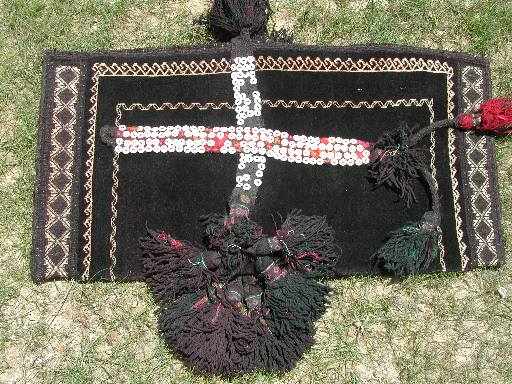
You have
to hold it at just the right angle to see that there's an intricate pattern
woven in deepest indigo on VERY DARK PURPLE
:
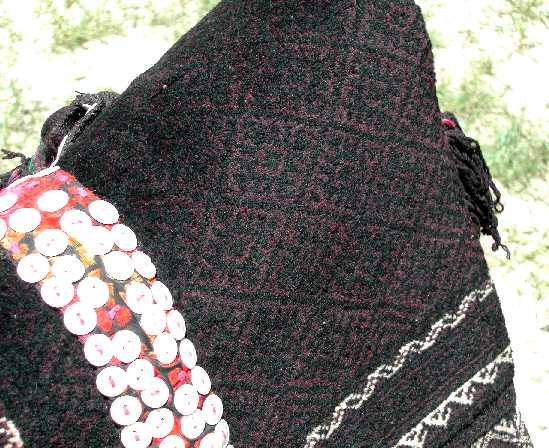
The
tassles are wrapped with cord made of twisted animal hair that is bound with
brightly colored cotton thread:
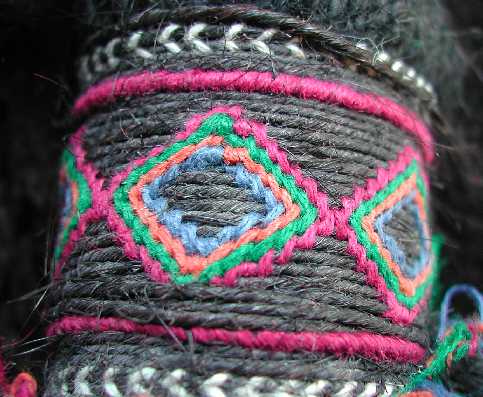
Even the square decorations in
the flatwoven panels are done with dark indigo and dark purple:
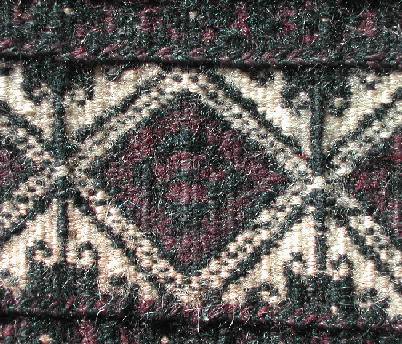
The next is a
bolesht piled with extremely thick velvety wool, with some very well done kilim
decoration. I'll show you a couple more later (when I find the images...). This
is the one with the darkest pallete, again very difficult to make out in
interior light.
The front:
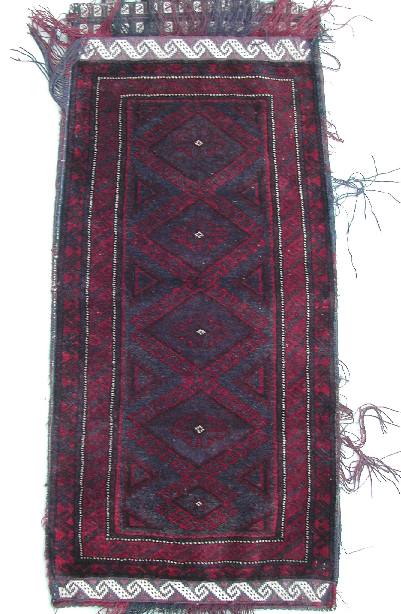
The back:
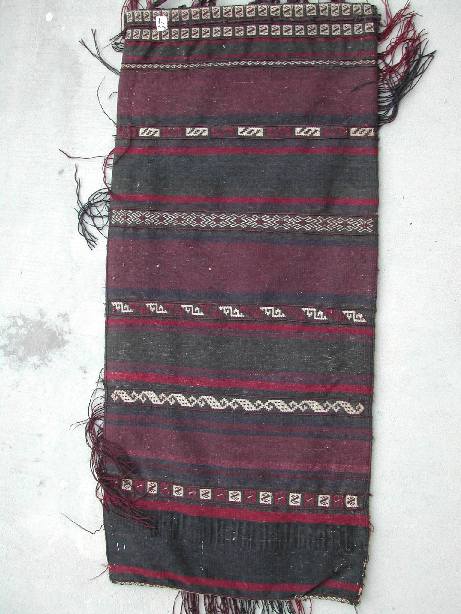
And a couple closeups of the
decorative panels. Note this one has a feature seen infrequently; a line of
fringe set in between the first and second decorative panels at the top of the
bag:
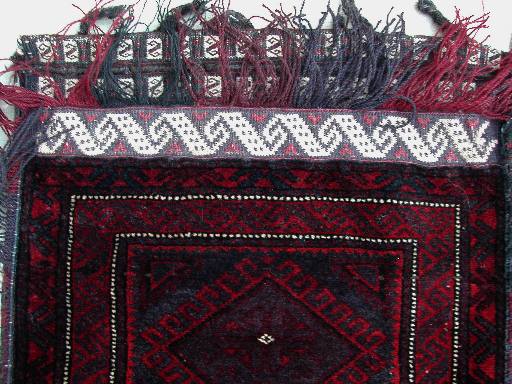
Detail
of the back:
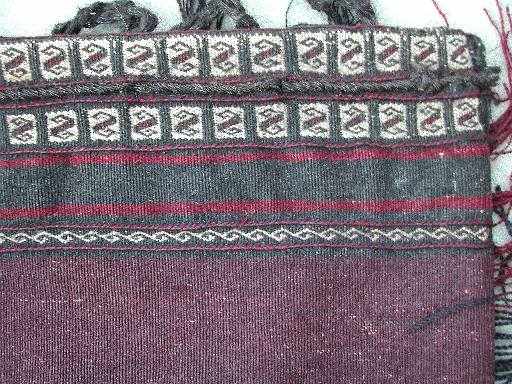
I think both of these are mid-20th century pieces. I'm
uncertain about attributions, although when colors are this dark you can't go
wrong suggesting Mushwani. The pattern on the bolesht is consistent with that
thought.
I have quite a few Baluchi pieces ( not many really old ones
 ), so we'll be chatting a bit
in this Salon.
), so we'll be chatting a bit
in this Salon.
Regards,
Chuck
__________________
Chuck
Wagner
Posted by Tom Cole on 05-28-2003 10:31 AM:
Chuck... looks like late Afghan Baluch weavings, very late. And the "bolesht"
is more probably something the Afghan traders would term a "pushti". The term,
'balisht' does not exist in the Afghan Baluch lexicon, for the most part,
certainly not in the areas in which these pieces you show were made (w.
Afghanistan). As discussed in HALI 76, "Mushwani" is not an applicable term, but
rather a market place term with little to no meaning in the real world of Baluch
tribal attributions. It is, at this time, an antiquated term which refers to
latch hook design, but not really to any specific type of weaving. I have seen
it used indiscriminately to describe Bahlul, Seistan and Afghan Baluch
weavings.
Posted by Filiberto Boncompagni on 05-28-2003 12:06 PM:
Dear Tom,
I never ventured into Afghanistan, as I understand you did
but …
R.D. Parsons, who worked there, mentions both pushti and bolesht -- no
explanation about the difference - while James Opie and D.H.G. Wegner describe
the balisht or bolesht as an elongated "head pillow" and the
pushti or poshti as a squarish "back pillow".
Parsons, Opie
and Wegner also mention the Mushwani tribe as the producer of those rugs with
latch hook design (Opies even suggests contacts between Mushwani and Kurds from
northeastern Iran to explain the origin of that design).
Are they wrong? I
have absolutely no problem in learning that, but I haven’t read your article on
HALI 76. Could you please present here a very short summary of it?
Best
regards,
Filiberto
Posted by Chuck Wagner on 05-28-2003 03:23 PM:
Good Company
Tom,
First, to address your guessing exercise, I'll propose that
number 4 is an Afghan Taimani piece. I've seen similar shades of red and
reddish-violet in Kawdani pieces, but (for me) the border places it with what I
know to be Taimani. Regardez:
A Taimani rug , roughly 5 x 8 feet, with
more browns and fewer reds than yours:
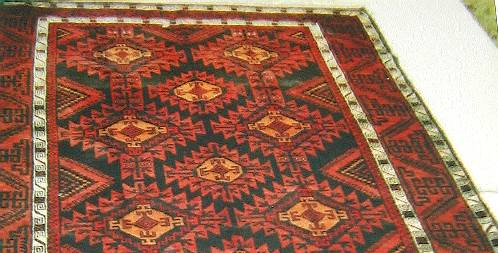
And an interesting ivory
ground Taimani prayer rug
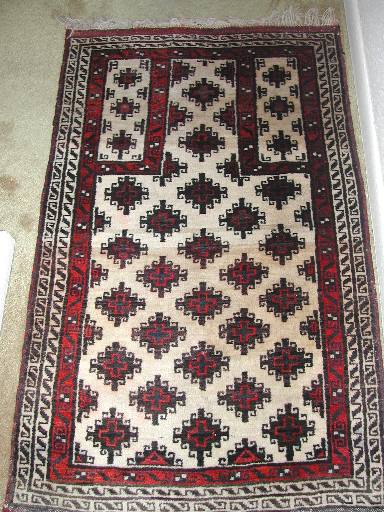
Next, I'd like you to elaborate on the time frames you put
into terms like early and late. There are very few Baluchi rugs around from the
early 1800's, and none that I am aware of from the 1700's. From a Turkoman
perspective, almost all Baluchi pieces are "late".
I'm curious because
the notion of moving into extremely dark colors, as a recent phenomenon, is
counterintuitive to me. With the onset of the use of inexpensive chrome dyes,
almost all the weaving cultures dropped the subtler vegetal dyes and went for
the bright colors they never had access to. This is especially true for Baluchi
pieces in the latter 20th century, many of which have the most awful bilious
yellows, grayish purples, electric blues, and bleeding greens and
reds.
It is true that dark palettes are still in use today in some
regions, mainly from the area peripheral to the Dasht-i-Margo, and from settled
Baluchis north of Herat. But such palletes were not uncommon in the late 1800's;
there are plenty of old pieces on the market made with dark blues, corroded
browns, dedp reds, and black.
An example of a more recent dark palette
that still has crisp execution is this prayer rug from the Farah
area:
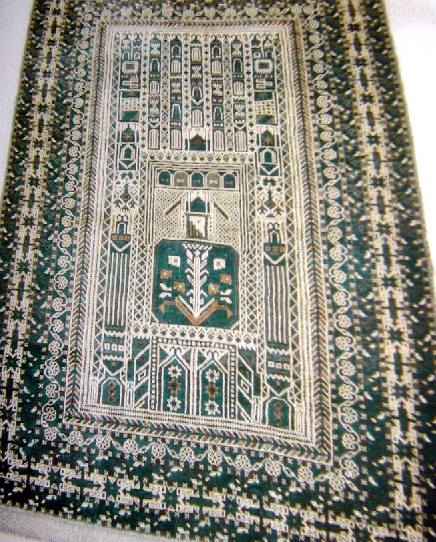
Lastly, we should add Murray Eiland to the list of those
possibly mistaken about the Mushwani (though he notes that it is a term that may
extend beyond simple tribal boundaries), and the native Afghani with whom I
often do business; the son of an old carpet hand from Chicken Street in
Kabul.
Regards,
Chuck
__________________
Chuck
Wagner
Posted by Tom Cole on 05-28-2003 09:10 PM:
Filberto.. Perhaps I am wrong, but such a distinction does not exist in my
experience in Afghanistan. All weavings called pushti were elongated cushion
type bags with flatwoven backs, either used traditionally for storage or in an
urban setting as cushions. No one ever called them balisht, nor does any Afghan
dealer ever call them balisht in my experience. And I do speak the language well
enough to over hear people's conversations, threads, etc. By the way it is
IMPOSSIBLE to summarise the HALI 76 article as it was a rather extended
interview with questions, and answers.. a wide ranging interview that covered
many subjects and many rugs.
And Chuck, regarding Baluch pieces with or
without colour, trust me... the OLD ones from Afghanistan have PLENTY of colour
and are never dark, mysterious or without colour contrast. I did not say ALL
late pieces are dark, mysterious and without colour contrast. The pieces you are
showing me are all on the later side.... decorative, ethnographic examples of
craft with roots in traditional design pools rather than indigenous tribal art.
I really do not want to get into a discussion of what is indigenous tribal art
at this time.. suffice it to say, art and craft are usually considered different
things, both of which have merit within their own context. Traditional tribal
weavings from the Baluch often have much to do with dowry, and ceremony rather
than a market driven enterprise. Such a definition extends beyond the Baluch
context as well... say with the Turkmen, and other weaving groups.
Posted by Tom Cole on 05-29-2003 11:07 PM:
Chuck... You got at least the one part of the puzzle correct on the detail
photo which you identified as "Taimani" and called it Afghan Baluch. It is from
Afghanistan, but it is probably not Taimani. In any case, the exercise is
designed to encourage us to avoid attributions and, instead, identify
provenance, a much more useful exercise as specific tribal attributions are
sometimes based on fantasy rather than anything real (ie. Mushwani rugs,
etc.)
Posted by Chuck Wagner on 05-30-2003 06:51 AM:
Pillow Talk
Tom,
Bolesht = Balesht = Balisht = Bolisht = Bolish = Balish, all of
which are Anglicizations of a word in common use for a pad or pillow. It is a
Farsi word, and, it is a Pashto word. I cannot speak for its presence in Dari,
Kyrgyz, Tajik, Rakshani, or other exclusively Baluchi dialects. So although you
may not have encountered it in your personal experience, it (like the Mushwani)
nevertheless exists.
As for the pieces I've shown so far, yes, most are
definitely not what we would characterize as true ethnographic articles, except
(in my opinion) the first which I believe to be a dowry bag. For me,
ethnographic does not by necessity equal old, so I draw a distinction that may
not suit everyone.
I agree with your observation that the design elements
of older Baluchi rugs are generally clearly visible, as opposed to the later
examples that I have shown. What I said (and spelled badly) was: "But such
palletes were not uncommon in the late 1800's; there are plenty of old pieces on
the market made with dark blues, corroded browns, dedp reds, and black." I meant
deep, not dedp, of course, but I do not yield the point. There is a difference
between palette and clarity. And the rug market is not exactly flooded with
gaily colored 19th century Baluchi pieces, a point which speaks for
itself.
And so, I consider you quite fortunate to be able to get your
hands on pieces that are not either 1) red, blue and brown, or 2) dark blue,
dark brown, and red. The green and peach tones are quite attractive. When do we
get to see the whole piece ?
As for the quiz, I'll take a shot at 10:
Adraskand, and 2: Khorasan.
Number 7 is most intriguing, it's not a
pattern commonly found in Baluchi work; the allover diamonds with latchhooks
look distinctly Central Asian, the sort of thing you find in Uzbek or Karakalpak
work.
Regards,
Chuck
__________________
Chuck
Wagner
Posted by Tom Cole on 05-30-2003 10:44 AM:
Number 2 is not Khorassan... too diverse of a palette, though the Turkmen
inspired turretted gol is an element more commonly seen in Khorassan rugs than
elsewhere... and #10 IS a w. Afghanistan weaving, whether it be from Adraskand
region or not, I cannot say but it is from w. Afghanistan.
A word about
the USE of words... tribal, nomadic, ethnographic, craft, art,
etc...........
Ethnographic does not preclude the fact that a rug is
late-ish. Late pieces produced for market are as equally "ethnographic" as those
woven out of a commercial context.
The words tribal and nomadic are often
confused, and Murray Eiland addessed that issue long ago in an ORR article.
Tribal does not mean nomadic, but nomadic inevitably indicates a tribal origin.
Tribal pieces were woven in sedentary environments.
And the market is not
flooded with gaily coloured Baluch material? No, it is not.
Posted by Chuck Wagner on 05-31-2003 10:57 AM:
Tom,
Do you have any ideas regarding this piece ? I never really gave
much thought to provenance other than to note that the color scheme has a
Turkoman look and feel to me. Thus I figured somewhere in NE Iran.
As you
can see, it has occasional touches of robins-egg blue here and there, a deep
irridescent blue in the border and the field ornaments, and quite a bit of
corroded dark brown in the field pattern detail.
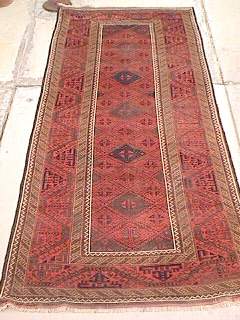
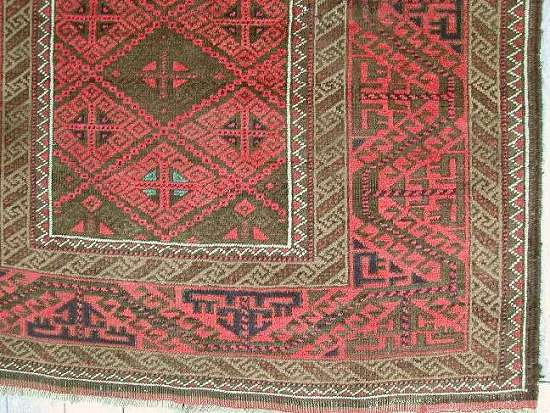
Regards,
Chuck
__________________
Chuck
Wagner
Posted by Tom Cole on 05-31-2003 11:08 AM:
Would much rather have YOU identify what is up on the discussion board rather
than me identify things in collections. The muted palette suggest NW Afghanistan
rather than NE Persia, somehow








 ), so we'll be chatting a bit
in this Salon.
), so we'll be chatting a bit
in this Salon.



